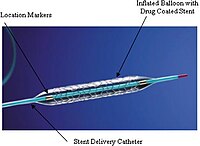
Photo from wikipedia
We investigated the safety and efficacy of biodegradable polymer drug-eluting stents (BP-DES) versus second-generation durable polymer drug-eluting stents (DP-DES) in a follow-up period of 5 years. A meta-analysis was performed… Click to show full abstract
We investigated the safety and efficacy of biodegradable polymer drug-eluting stents (BP-DES) versus second-generation durable polymer drug-eluting stents (DP-DES) in a follow-up period of 5 years. A meta-analysis was performed using data from the PubMed, EMBASE, and Cochrane Library databases. The primary endpoint was target lesion failure (TLF), a composite endpoint of safety and efficacy, which included cardiac death, target vessel myocardial infarction (MI), and clinically indicated target lesion revascularization (TLR). Secondary endpoints were all-cause death, MI, TLR, definite or probable stent thrombosis (ST), and definite or probable very late ST. In addition, we performed subgroup analyses based on patient and stent characteristics. Nine randomized controlled trials (RCTs) in 11,817 patients were included in the meta-analysis. Compared with second-generation DP-DES, BP-DES was not associated with increased risk of TLF (odds ratio (OR) 1.06, 95 % confidence interval [CI] 0.94–1.20; p = 0.33), all-cause death (OR 1.04, [0.92–1.18], p = 0.49), myocardial infarction (OR 0.97, [0.83–1.13], p = 0.67), target lesion revascularization (OR 1.08, [0.94–1.23], p = 0.27), definite or probable stent thrombosis (OR 0.85, [0.66–1.11], p = 0.24), or definite or probable very late stent thrombosis (OR 0.86, [0.58–1.26],p = 0.43). Furthermore, the subgroup analyses did not reveal any statistically significant differences between the stent groups. At 5 years of follow-up, the safety and efficacy of BP-DES are clinically comparable to those of second-generation DP-DES.
Journal Title: Cardiovascular Drugs and Therapy
Year Published: 2019
Link to full text (if available)
Share on Social Media: Sign Up to like & get
recommendations!